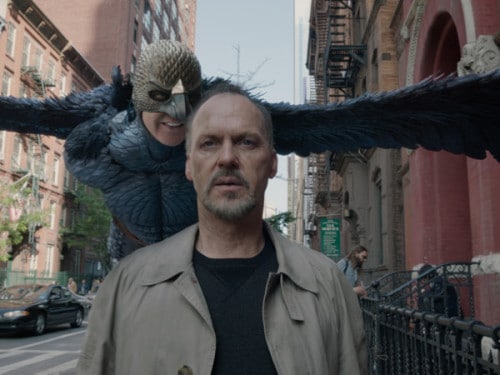
Following up our podcast on Birdman‘s genre, here’s the beat sheet from a brilliant new contributor, Selin Sevinç:
Birdman: Or (The Unexpected Virtue of Ignorance)
Screenplay by: Alejandro G. Iñárritu, Nicolás Giacobone, Alexander Dinelaris Jr. & Armando Bo; based on the Raymond Carver story, “What We Talk About When We Talk About Love”
Directed by: Alejandro G. Iñárritu
Genre: Rites of Passage
Opening Image: Hero in meditation. His voice-over says, “How did we end up here? … We don’t belong in this shithole.” Perfect opening for a character who will soon begin questioning his self-worth, the meaning of his existence and above all the reality of all that is. As he is levitated during meditation, we are led to think Riggan Thomson (Michael Keaton) may be talking about the notion that all that we see, feel and think are perceptions of a grand illusion (maya), and in fact “this” is not our true nature – we do not belong “here” in the world of maya.
Theme Stated: Riggan is haunted by the superhero character that he played many years ago: Birdman. Birdman, the alter ego, tells Riggan that he will fail at his comeback in the theatre. He should give it up already and embrace his superhero persona instead. Riggan, either in reality or in his personal reality, does have supernatural abilities. We are left to doubt until the very end whether he is an extraordinary person doubting his extraordinariness, or a perfectly ordinary person doubting his ordinariness. Is he a potential winner or a loser?
Set-Up: Riggan at a rehearsal for his comeback play. We observe him publicly exercise his superpowers, about which we remain doubtful. We meet his alter-ego, producer, daughter, fellow actors, lover, ex-wife. We get the sense that things are going badly for this guy. When all he wants is to prove that he is something, he grows more and more fearful of firmly establishing himself as a nothing. He is desperate for acknowledgment and success, but also strangely aware that “this” is not “it.”
Catalyst: The catalyst is an amalgam of Riggan’s external and internal conflicts. On the one hand there is the question of whether he will really take on this crazy challenge of succeeding in the theatre and whether the incredible risk he is taking will pay off. On the other, his internal conflict is with his own ego. Will he be able to overcome it, silence it, stop battling with it? He also has a hyper-conflict: Are his superpowers real? Is he and everybody and everything else real? All of this is set up from the first instant we see and hear Riggan. His catalyst lies within himself. But if I had to pick a scene that is cataclysmic for his journey, I would pick the scene where he supernaturally “kills” his co-star and takes charge of his destiny by changing it for the better against all odds.
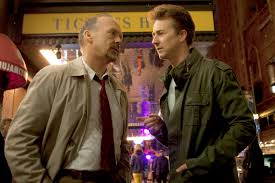
Debate: The hiring of Mike (Edward Norton) and the previews that follow. The one-on-one rehearsal with Mike reveals Riggan’s weakness and self-doubt. In the first preview Mike messes up the whole show by insulting Riggan and the audience. Riggan has to decide whether he should keep Mike, who will clearly be instrumental to his success, despite the risk of damaging his ego along the way. Right after the preview, Riggan and Mike have a conversation where we get to know who they are and what they are in this for. The stakes are high for Riggan: this play is a make-or-break for his career and seemingly for his entire existence.
Break into Two: This is a tough one, because almost the entire film seems to be a debate about all the explicit and implicit questions raised at Fade in. A prominent Break, if not the Act I Break, is the scene where Riggan’s daughter, Sam (Emma Stone), pummels Riggan’s ego by telling him he is unimportant and he better get used to it. Riggan is clearly devastated. But after she leaves, despite his apparent “loser” outlook, he uses his magic to give the ashtray a gentle spin, as if to say, “Yes, I know, but there is something else….” Meaningfully, in the scene that follows, his stage character says, “I spend every fucking minute praying to be someone else. Someone I’m not. … I don’t exist. I’m not even here. I don’t exist. None of this matters,” and then shoots himself. The Riggan-Sam scene tips Riggan over to the throes of an even grander battle with himself.
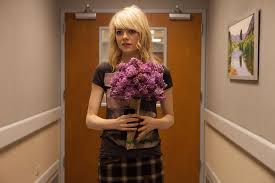
B Story: The traditional love story credit would be given to Mike and Sam’s developing romance. But I feel Riggan’s relationship with his daughter has the only B Story quality. At the Act I Break scene I mentioned above, Riggan is sympathetic toward Sam for the first time, and their relationship flourishes throughout the rest of the film. Sam will also become the first to find out about Riggan’s “true” identity. Theirs is the true romance of the film.
Fun and Games: All the previews up to the first time Riggan reads a review of the play.
Midpoint: Riggan receives a review where Mike comes across as the star of the play and he, “the aging action hero who grasps for his youth.” Riggan experiences a false defeat. He is once again pushed to the edge to choose between his ego and his dignity (which also stems from ego – there is no way out of the ego trap!).
Bad Guys Close In: Ego wins! Mike stays on as a threat, but he is no more of a threat to Riggan than his play’s failure. Riggan continues to take more risks for his ultimate goal of making his great comeback. But the pressure builds. Mike becomes more and more of a problem on so many levels, including as a love interest to Sam. Birdman insults and dares Riggan more than ever and drives him to the edge of sanity.
All Is Lost: Tabitha, the influential critic who will give the life-or-death verdict on Riggan’s play, makes her decision before she even sees it: “I’m going to kill your play.”
Dark Night of the Soul: After hearing his fate, Riggan truly gives up the fight for the first time. The whole world is against him. There is no chance that he will survive the assault and he has not a drop of hope left. He wakes up on a bench and peels his face off a garbage bag, appearing more like a homeless drunk than a superhero. Birdman brings in the big guns to take advantage of Riggan’s weakest moment and lure him back to his side. Riggan falls for it. But, does he fall into Birdman’s trap, or is he building up the courage to step into his power. He ends up on top of a building, seemingly about to commit suicide. When a neighbor helps Riggan step down from the edge and asks, “Do you know where to go?” Riggan responds, “Yes. I know where to go,” and jumps off the rooftop without hesitation. Riggan soars high over Manhattan, just like Birdman.
Break into Three: Riggan is a superhero now, and he knows exactly what to do. He has the solution but we don’t yet know what it is. He plans his “real” suicide at the end of his opening show. Why? Because he knows he will fail, so he might as well make the most majestic exit he can? Or, now that he discovered his superpowers, he simply knows nothing can beat him, whatever happens will only serve him? We don’t know why exactly, but we know something is up when he prepares to pull the trigger.
Finale: The Third Act is set in the hospital room where Riggan lies with a bandage on his face that is practically the same as the Birdman mask. He not only survived the suicide attempt, but he also gained enormous sympathy from audiences and family alike, picked up great reviews and got himself a brand new nose!
Final Image: Riggan takes flight! From the opening image of a levitating man in meditation to a closing image of a man in flight from the POV of his daughter… What did Riggan figure out: that he doesn’t belong in this shithole. And he proved it.
Selin Sevinç
13 Comments
Leave a Reply Cancel reply
You must be logged in to post a comment.


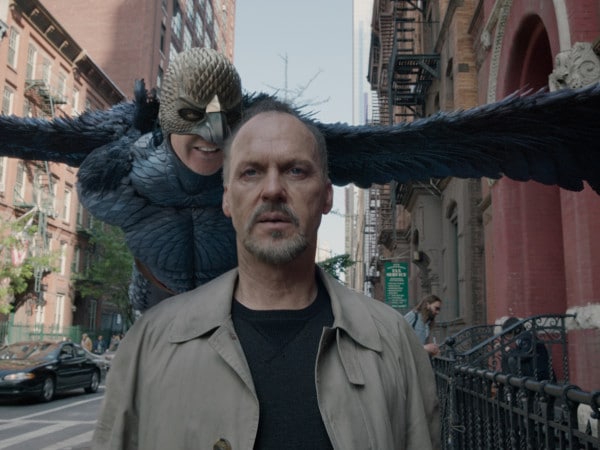
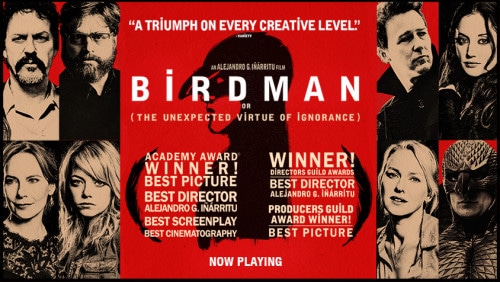







Great break down of BIRDMAN, but I still fail to get it. I saw the film, aside from the great acting and setting in the heart of Broadway, I did not like the film at all. I didn’t get the connection between the protagonist and his fantasies. It was too surreal for me. Was he hallucinating? Was he really a super being with these powers? I was pissed it won an Oscar, thought CAKE was a lot better. But, that’s just my opinion, of course.
:) I personally like to think of it as a movie about a man who is driven to the very edge of his sanity by the events in his life and in his mind that he is finally ready to jump of a cliff, but is -metaphorically or in reality- saved by ‘himself’ – his allpowerful true nature. I think the film questions reality and truth about life and our nature in a very clever way. Who knows what humans are capable of? Who are we really? What are we here for? And ultimately the unlikely hero soars as we, too, can.
Quite likely the most flawed Beat Sheet this site has ever posted.
A terrific film, though, that makes no effort to hide the fact it draws great influence from the worlds of magical reality, as seen in the work of Gabriel Garcia Marquez (One Hundred Years of Solitude).
Unfortunately, this Beat Sheet is an incomplete and inaccurate analysis.
Not only is it scant where detail is needed and fumbling where clarity begs, it asks too many questions it can’t answer.
Considering these Beat Sheets are merely retrospective analyses made to fit into the Save the Cat notion of structure, they should at least achieve that objective.
They should not be vague.
And they should at least pass as accurate within the principles the site prescribes to.
If not, as is the case here, best not to publish them.
Hi Elliott,
Thank you. I would love to know your interpretation of beats and what points you need clarified.
G’day Selin.
The thing is, it’s not clarification I’m seeking.
The suggestion is that the Beat Sheet needs work.
One cannot just scantly summarise the entire first half of Act 2, particularly with a Beat such as Fun & Games.
Same goes for Act 3.
The Catalyst has to be clearly defined as ‘the day unlike any other’.
Large or small this is that moment that sets the wheels in motion.
One thing it is not, is questionable.
The question to determine this Beat is simple: would the events of the story happened if this moment had not occurred?
Would the events in Sunset Boulevarde have occurred if Joe Gillis had not fled in his car and turned into the road that led to Norma Desmond — from who he’d never escape?
No, they would not have.
I would encourage all Save the Cat readers to study the Beat Sheet for Jurassic Park.
You’ll find it is an analysis that shows structure for what it is, and how Beats, which are merely identifiable landmarks along the way, have a life of their own.
It’s a Beat Sheet that serves the story, not the analysis.
And it shows just how flexible one must be with plot in order to achieve tight, straight, unwavering structure.
One Last Thing:
To help better understand Birdman, it has to be seen for what it is to those who populate its world.
Yes, we can define it in literary terms as Magical Reality, but the characters don’t know this.
This is their world.
All that happens is within their reality.
Riggan does levitate during meditation. He does move objects. He is the Birdman.
He doesn’t imagine his reality, and others aren’t shocked by it as if it is extraordinary.
Remember, this is ultimately a story about the unexpected virtue of ignorance. And therein lies the story’s beauty, magic and its secrets.
I agree with Elliott E. Carter’s comments regarding this beat sheet summary of Bird Man. Sorry Selin.
Carol
Elliott, I understand you have a very clear idea of how beat sheets should be written and how my approach and style didn’t meet your expectations. Sorry to hear that.
As an analyst, I try to summarize the scene or the story point(s) to communicate to the reader: (1) what happens in that particular scene(s) that qualifies it as a beat; (2) why I see it as the beat; (3) what this beat means for the story as a whole. I assume the reader has seen the movie and has some knowledge of what the beats entail according to STC! (hence the fairly short Fun & Games, which I feel is a pretty straightforward part of the puzzle, as is the brief 3rd act). I write it this way specifically to give the reader an opportunity to relive the events of the story as they correspond to the turning points identified by Snyder.
I think any beat sheet serves the analysis too, because it is essentially an analysis of the story from an individual’s perspective. Screenwriters may easily have meant another point in the story to be the midpoint or even an Act I Break. I don’t think anyone can say, ‘this is the midpoint beat, period,’ nor do I believe the power of the story is any less because of a difficulty in firmly determining its beats. If the story works, it works because of a million reasons. By nature all of this article is open to discussion. If you have a different moment in the story you are able to identify as a ‘Catalyst’ beat, about which you clearly have a very good grasp, by all means let’s discuss that beat. It is one of the most challenging beats of the story. In fact, the whole narrative is a challenge. So instead of focusing on this particular interpretation’s weaknesses, let’s try to add to it and make it better together.
In response to ‘One Last Thing’:
I saw Riggan as a man who is rejecting a part of himself and suffering from a spiritual/existential doubt about who he is and what he is capable of. His whole journey is one of self-realization. I saw this as the theme of the movie. And the story holds more power because of Riggan’s initial ignorance, which we share with the hero. I agree, ‘therein lies the story’s beauty, magic and its secrets,’ as you very well put. The elusiveness of this theme and how the writers/filmmakers deal with it may have something to do with a certain ‘vagueness’ in the analysis.
All true, Selin.
Nice to chat with you.
All the best…
Great film great analysis. Am so shocked at how many people don’t get this movie: All the world is a stage …..the whole world is there including our delusions? Loved it and the music? Sublime.
Great beat sheet. I personally didn’t understand what all the fuss was about this movie after I saw it, and I was frustrated by all the “is he or isn’t he?” questions I was left with, so it was great to read an analysis of this movie with the beats framed by the questions and (sort-of) answers the movie poses in each section. Made the story much clearer to me.
Great to hear the beat sheet added to your enjoyment of the movie. I think the questions that are raised in the movie remain to be answered by each of us. They are what made the movie such a marvel for me.
This beat sheet makes a LOT of assumptions.
I’ve seen this movie three times and I think you’re assuming he had magical powers (as I did on first viewing.) Upon subsequent viewings it became clear those powers all in his head. There were time lapses when he thought he had superpowers and they only occurred when nobody else was around.
He didn’t fly over the city, he only imagined he was. He was actually in a taxi. He didn’t throw posters with his mind, he threw them with his hands. And at the end. Well, that’s a tricky one, but he probably didn’t even jump out the window. He walked out of the room.
You know, I appreciate the attempt to fit the story into Blake’s beats, but Blake’s beats are his beats. Others have beat outlines, too, and they are very similar to his.
We have a life being lived … a dysfunctional one … that gets upturned and the person works at bringing it back to their ‘normal,’ to ‘fix it,’ or to understand the upturn, but it only gets worse.
Add in an ally or confidant (love interest or not) … one with whom the main character can confide in, talk to like with no one else, and share his thoughts, feelings, doubts … in essence, help us the viewers / readers / listeners bond with them emotionally through this relationship with their ally, and as they get insight into themselves (eventually), and perhaps be a key to the final turnaround at the end of the story.
At one point after much to do about it, after lots of ‘fun and games,’ he/she believes she’s conquered or lost, but that’s not the case. Things are different than what it appear to be, and they learn this soon enough. The question we get in our mind at this point, which keeps up glued to the story is … “Do they have the courage or character to continue on?” This is their most telling moment, their ‘darkest hour’ or should we say their illuminating moment? Their moment of realization upon deep soul searching of something they needed to learn all along? So, what do they do about it? Do they use this to move forward and finally conquer (usually with the help of some friends and/or the ally), or do they fail to move forward and waste the realization only to end in tragedy? If it’s a ‘positive’ ending, we finally see / read / hear about how their former ‘normal’ life has changed a bit (or a lot). This one has a positive end.
Right? So, however you want to break a story up into sections and call them beats varies. Blake suggested a way, but it’s not the only way. It’s a useful way, but not the only way. So, let’s not quiver about how well someone attempts to fit a story into his beats. Let’s just appreciate it and cut the person a break. There are other story – Blake beats attempts that I’ve read that didn’t quite make it, but so what?